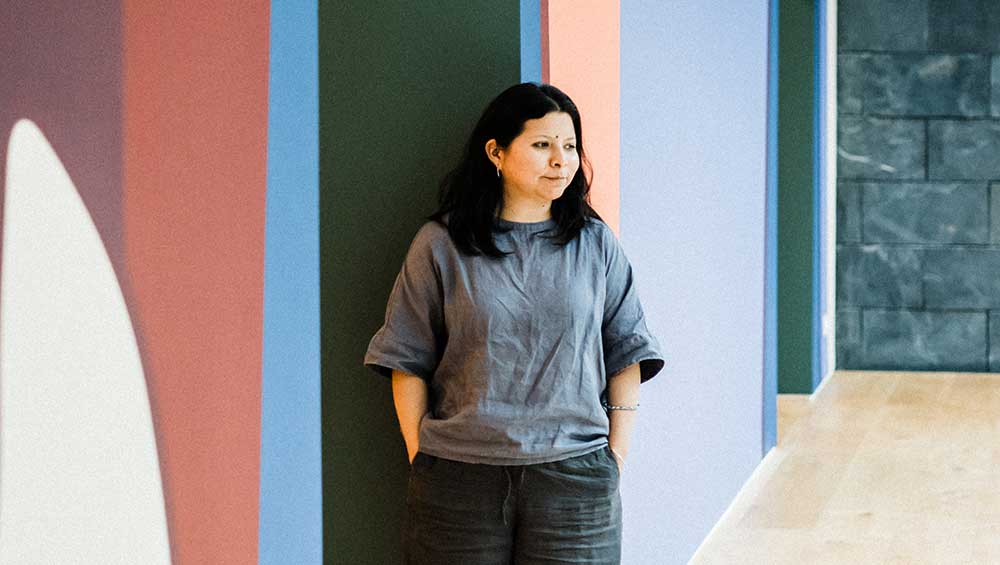
Portrait of Claudia Martínez Garay, 2023. Photo: Lais Pereira.
by VERONICA SIMPSON
The work of Claudia Martínez Garay (b1983, Peru) interrogates the impacts of colonialisation, local and global, cultural and emotional. The artist, who lives and works between Amsterdam and Lima, examines not just the Spanish invaders’ oppression of Indigenous populations in her homeland of Peru, with the extinguishing or appropriation of more ancient and indigenous cultural practices, but also the shipping of archaeological remains from that region to Europe and museums around the world. Her work Wakchakuna/We Who Share Everything and Nothing at Nottingham Contemporary exhibits a great earth mound encrusted with such finds, all of which are copies of originals that Martínez Garay has made, based on artefacts in the collections of museums in London, Scotland and Berlin.
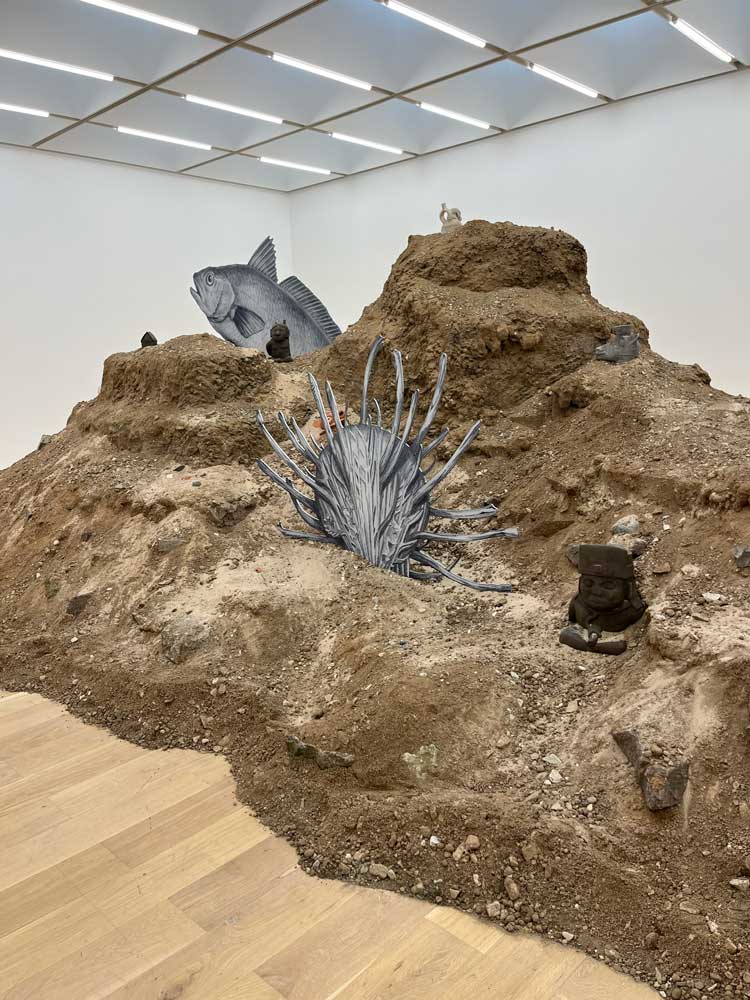
Claudia Martínez Garay, Wakchakuna / We Who Share Everything and Nothing, installation view, Nottingham Contemporary, 25 May – 8 September 2024. Photo: Veronica Simpson.
Fascinated by the stories of how these artefacts reached museum collections, and how little is often known of their provenance, in Nottingham, Martínez Garay has reproduced examples of the curatorial or historical notes in a large, foldout leaflet printed for the show, with each object numbered and given its catalogue reference and description from the current “host” museum. One object, for example, from the British Museum is simply described as: “Found in Americas collections apparently unnumbered and unregistered. Formally registered March 2013. Acquisition details unknown, but known to have been in collection by 1955.” The artist wants to remind us that this thing may have once been someone’s most treasured possession, yet those cursory notes are brutal, dismissive.
The first of Martínez Garay’s installations of this kind were seen at the Istanbul Biennial 2019, and later shown at Frieze London, demonstrating the casual abuse and arrogance of colonial-era kleptomania. But her research into what is acquired has revealed some strange, and occasionally baffling, objects. As her knowledge of the original cultures and craft practices advances, she notices a strange, collaged quality to some of the artefacts, indicating possible fakery along the way: sometimes these are made using ancient, excavated moulds, but with contemporary clay or textures or decorative features. This, in turn, can be seen as an analogy for our human histories, a layering of cultures and practices that is ever-changing, with value systems entirely dependent on context.
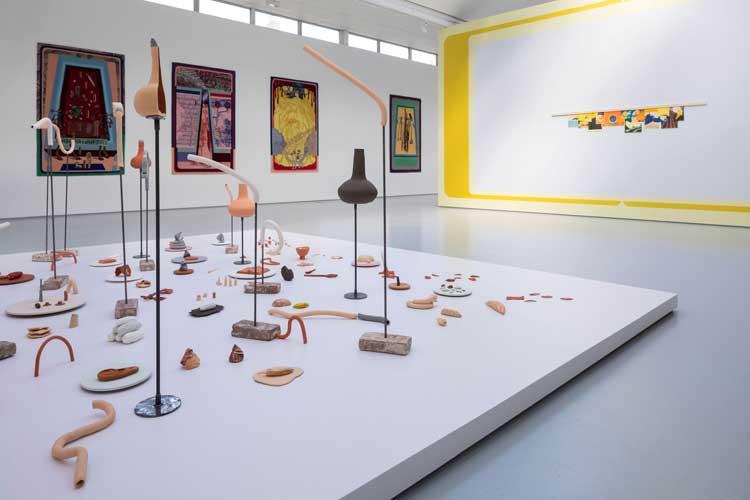
Claudia Martínez Garay: Every seed is awakened, installation view, Dundee Contemporary Arts. 24 August – 17 November 2024. Photo: Ruth Clark.
For the show at Dundee Contemporary Arts (DCA), Martínez Garay presents individual iconographic sculptures, as well as collaged print, textile and animated works that demonstrate her deep research into the original collectors and chroniclers of Andean culture. There are new commissions, including a bold, graphic painted mural and a polyptic of new prints created in collaboration with DCA’s world-class print studio. There are also several pieces from the artist’s Pacha series of tufted works, begun in 2020, and named after the Quechua concept drawn from the Andean cosmovision of undivided unity in time and space. Martínez Garay’s installation from the 21st Contemporary Art Biennial Sesc_VideoBrasil, in São Paulo in 2018, ¡Kachkaniraqkun!/¡Somos aún!/¡We are, still! (2018) has also been reconfigured for the DCA show.
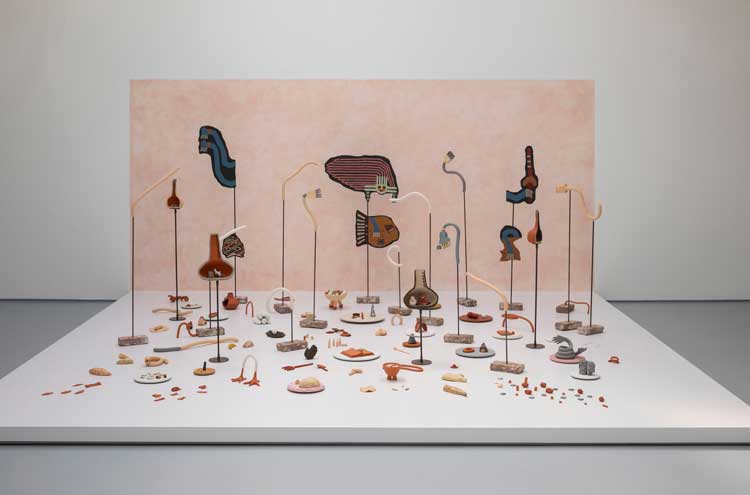
Claudia Martínez Garay: Every seed is awakened, installation view, Dundee Contemporary Arts. 24 August – 17 November 2024. Photo: Ruth Clark.
The artist originally studied printmaking at the Pontificia Universidad Católica del Peru, and her practice developed further thanks to a residency from 2016-17 at Amsterdam’s Rijksakademie van Beeldende Kunsten. She is represented by the Grimm gallery. Her work is in many international collections including: the AkzoNobel Art Foundation, Amsterdam; the Academic Medical Center Art Collection, Amsterdam; Fondazione Benetton Studi e Ricerche, Treviso; Central Reserve Bank of Peru, Lima; Cisneros Fontanals Art Foundation, Miami; Denver Art Museum; the Kadist Collection, Paris and San Francisco; KPMG Art Collection, Amsterdam; LAM museum, Lisse; and the LOOP Collection, Museu d’Art Contemporani, Barcelona.
Studio International interviewed the artist in person in Nottingham and on Zoom before the opening of her Dundee show.
Veronica Simpson: I am curious about how you choose the objects you use in your works. At Nottingham, for example, what inspired you to present this particular collection of artefacts in the Wakchakuna installation?
Claudia Martínez Garay: With this work, I was specifically checking UK collections. Sometimes, I check online and sometimes I visit the spaces. I went to the Pitt Rivers Museum in Oxford, the British Museum and the National Museum of Scotland, the archaeological part. Throughout my career, my work has been based on history and archives. Before working with more ethnographic or ethnological themes, I was working with propaganda because I was very interested in what happened during the conflict in Peru.
I went to the Netherlands on a scholarship to do a residency. I was visiting museums and, as they were telling me about all the Dutch masters, I noticed all the amazing things they have and the pride they have in their collections. And I wondered what was the equivalent for my country, what would be held in the same regard in Peru? I was looking at ceramics from the Moche culture, from the north of Peru, which is the desert part, and that was incredible because I started to learn more about the culture – not only the amazing ceramic skills, but all the rituals and the history of why they made those things. I started to wonder why these objects were outside Peru and how they found their way to the Netherlands. So, some of the objects are in there because they are great visually and others because of all the things we can discuss about them.
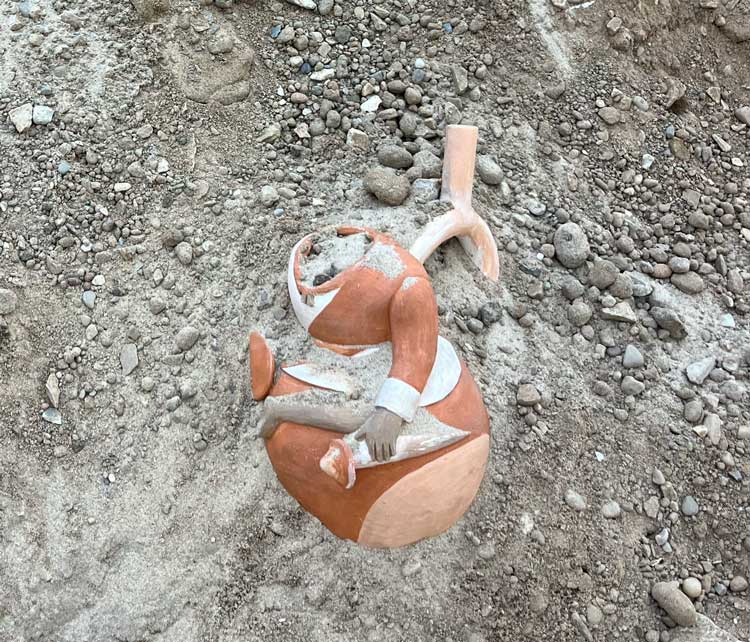
Claudia Martínez Garay, Wakchakuna / We Who Share Everything and Nothing, installation view, Nottingham Contemporary, 25 May – 8 September 2024. Photo: Veronica Simpson.
Peru was one of the biggest exporters of guano to the British. Some of the relics were dug out with the guano and found their way here. I know this from talking with a curator of pre-Colombian artefacts, from Peru, who was working in the British Museum. She said how special they were and that there are not so many of them in Peru. But it’s not like you can just go and see them in the museum, because they are in storage, and you have to ask many permissions - it’s restriction after restriction. These questions are all important when I’m thinking about my work.
VS: It sounds as if you need to do a lot of excavations yourself to find or see the items.
CMG: Yes, and I think the uncertainty of these objects is as great as their value. They know it is a ceramic, they know it may come from the area that is now part of Peru, but they are not considering the previous cultures, all the layers of history that went before. Sometimes in between eras there are completely different cultures, many centuries of difference. Some of the pieces are fake. And sometimes the museum knows this, but they keep them anyway, even though they have an idea they may not be genuine.
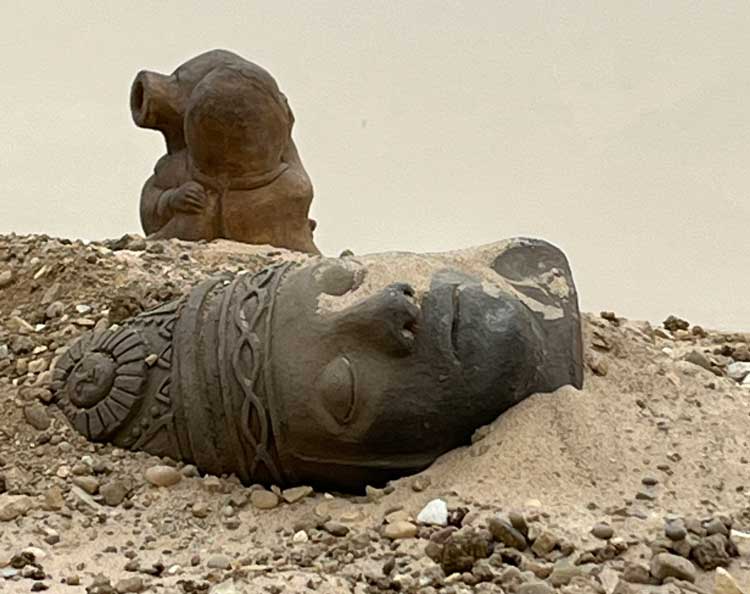
Claudia Martínez Garay, Wakchakuna / We Who Share Everything and Nothing, installation view, Nottingham Contemporary, 25 May – 8 September 2024. Photo: Veronica Simpson.
VS: Talk me through some of the objects you have in this pile (in Nottingham) – for example, that head of a woman, wearing a headdress, lying on its side.
CMG: This one I asked to see because it seems a very strange piece. The face is obviously from the Moche, on the north coast, but the iconography from the headdress is obviously Inca, or at least it’s not Moche. It is very different iconography. I felt that this piece must be very special or extremely weird, but unique in a way that doesn’t make sense. It was also like a collage … I work a lot with collage. And that’s when you start learning about your history. It’s not like you start with a timeline and stay on it. I am reading about art from the 1970s at the same time as I am checking things from (dynastic) culture. Everything is mixed up in a way. When I asked for this piece, the curators were curious about why I wanted to see it. They were almost protective. I said it’s strange because this kind of face is a real person’s face – quite often they made sculptures from moulds, but a few are depictions of real people. And if that’s true, with this portrait, its initial purpose was to be under earth.
VS: You mean part of a burial ritual or cache?
CMG: Yes. Most of them were accompanying bodies into the afterlife. In other cultures, it’s the same. And when these objects are separated from their funerary context, it’s difficult to trace them and for the original communities to claim them. I told them that I don’t think that headdress has the iconography from Moche as they don’t do the sun symbol. The sun is very much from the Inca, and fire. The Moche are more interested in the moon.
Also, normally, the pottery from the Moche is very thin, very light. And this is heavy. I then ask: “Why is it interesting for you to have these objects in your collection?” On the other hand, for me, it’s interesting that culture disappears. And the Moche was absorbed by another culture later, and it must have developed somehow. And is that still relevant or important, or not? Most of the time, that’s the problem in Peru. We appreciate the archaeological and older histories more than the people who continue with those crafts and these practices now. The differentiation between art and crafts is very much embedded, and I am a bit against that because I think it’s all just another way of approaching everyday life.
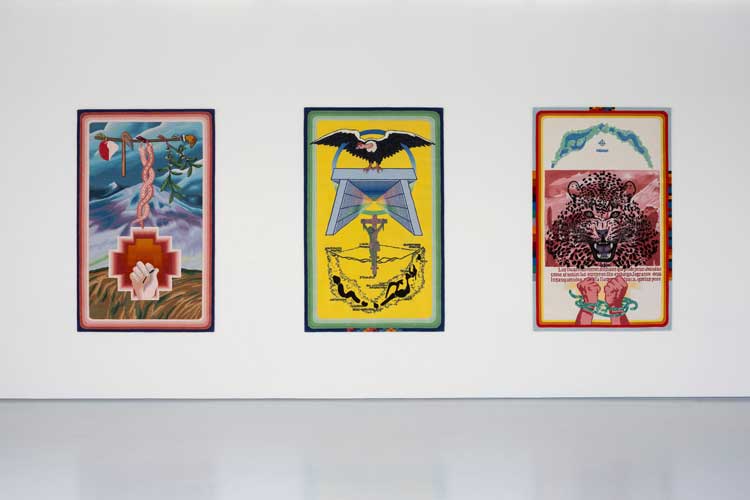
Claudia Martínez Garay: Every seed is awakened, installation view, Dundee Contemporary Arts. 24 August – 17 November 2024. Photo: Ruth Clark.
In Nottingham, I am presenting a film (Ñuqa Kausakusaq Qhepaykitapas/I Will Outlive You, from 2017) that shows my first project that related to Moche culture. For that video, I went to an ethnological museum in Berlin and made a photogram of one of the prisoner sculptures there. [The Nottingham installation features several of these prisoners, small-ish figures who have their hands tied behind their backs, and often have a snake or rope around their necks.] To me, these are the pieces that are important to discuss. It’s not the big, golden giant statue I am interested in. And these prisoners are still kind of in prison. These portraits of prisoners were made before they were sacrificed and then buried. And now they continue to be locked up in storage.
I read a lot about the culture and to see, for example, what the purpose of the sacrifices was. We still have floods in the north of Peru, because of El Niño. But this culture experienced floods more than 1,200 years ago, and, of course, they didn’t know what to do when it flooded, or when there was a drought. They felt they had to make sacrifices when it was really a life-or-death situation. One of the things they did was to put seashells in the bodies of water, to ask for rain. There was a moment when El Niño caused rain that was so heavy, it wouldn’t stop and wouldn’t stop. Their cities were mud cities, so they started making sacrifices for the rain to stop. I know that because, in one of these layers archaeologists found about 70 bodies and that wasn’t normal.
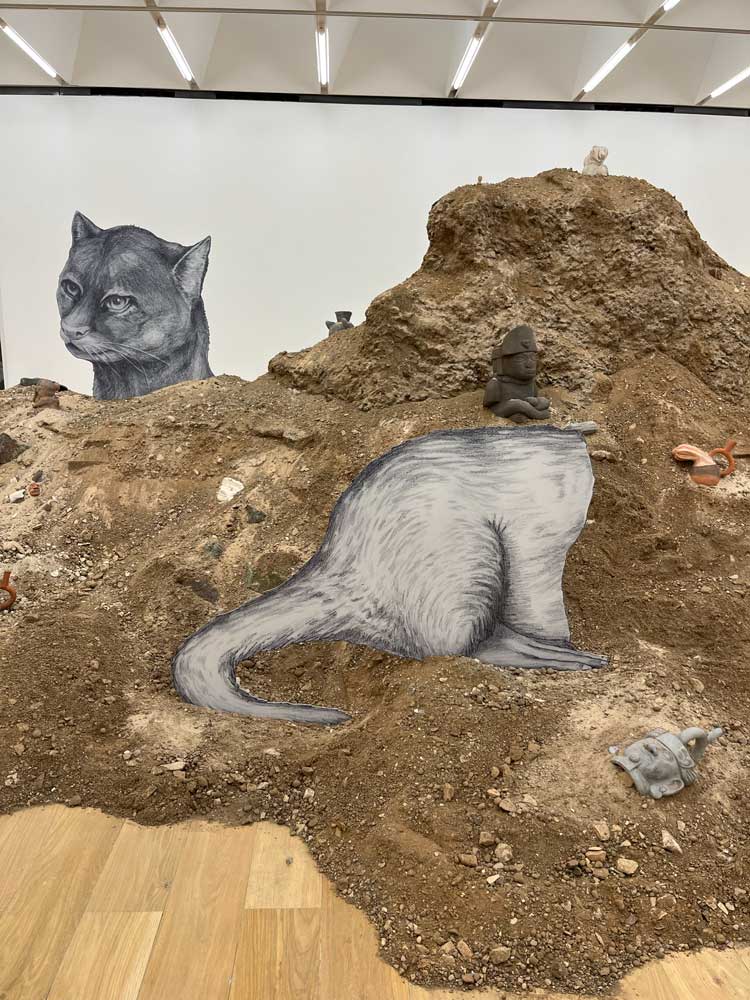
Claudia Martínez Garay, Wakchakuna / We Who Share Everything and Nothing, installation view, Nottingham Contemporary, 25 May – 8 September 2024. Photo: Veronica Simpson.
VS: When you create these earth mounds for your installations, is it those geological layers, that sense of archaeology you wish to evoke?
CMG: I wanted to hint at a desert, where some of the pieces come from. Some of the smaller pieces, like the little women in the top, these were interesting because I’m not necessarily working just from the Moches, because they were the most prolific ceramicists, but these pieces are from the Incas, and they buried them in the highest part of the mountain. For me, this is like a mountain. But it could also be like an island or a desert, a place where these objects were put, but that are all now separated from their original place and purpose and some are not able to be traced. For me, that kind of blurriness is something that, in a space like this, should be revealed.
When I was a baby, I could only speak Quechua. When my family moved me to Lima, I could only communicate with my grandparents as most of my family didn’t speak that language. I was learning Spanish at one and a half. Since I moved out from Lima, I have been thinking specifically of my ethnicity. I started with Quechua lessons, and I’ve been trying to study some of the concepts that are important to share because they are almost unique. In languages, some words cannot be translated but they express so much about the culture. Wakchakuna, for example, means “the poor”, but not poor in the sense of not having money. It means you don’t have community, or family that you can rely on, so you are doomed to not be able to survive. So, when thinking about the objects in the museums abroad, the term Wakchakuna makes sense.
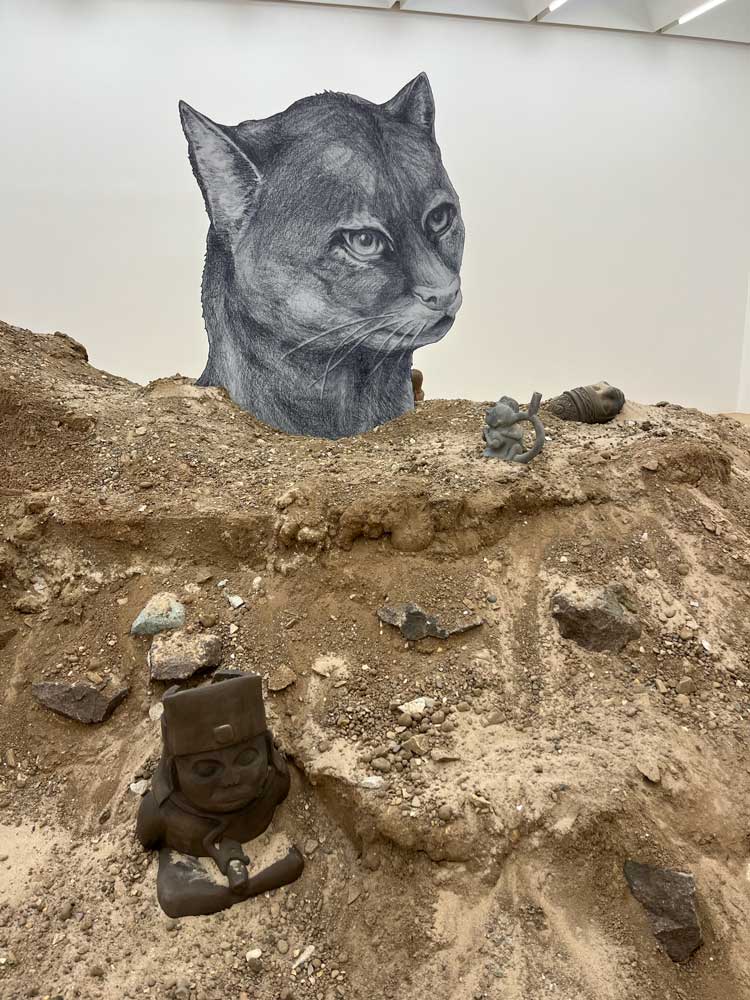
Claudia Martínez Garay, Wakchakuna / We Who Share Everything and Nothing, installation view, Nottingham Contemporary, 25 May – 8 September 2024. Photo: Veronica Simpson.
VS: Can you tell me about the drawn objects in the mound?
CMG: Within a burial site there would be bodies and objects that were meant to accompany them to the afterlife, but animals were also buried. I didn’t want to work so much from the actual relics, of bones, but I wanted to redraw them in a way to animate them and make them come alive. In the drawings, I use a small scale, but I wanted to reprint them big, in metal, to give this kind of strangeness, with a different media. I like to work in sometimes opposite levels - something very small with something large. I often make ceramics that are very small, but the tapestries that are going to be in Dundee are really large.
VS: Do you feel that playing with scale and materials in this way communicates a sense of disconnection? Reflecting the way these objects are disconnected from their origins, their meaning?
CMG: I think the scale can sometimes have different meanings. Some of the pieces of ceramics are small because they represent something very special that you are meant to bring to the afterlife, to carry with you. That little woman, for example, is a piece that is meant to be the most precious, like children or animals or a house. They are precious things because you would give or bring the most precious things.
VS: For Dundee, there are new works, including some prints you have made at DCA’s fantastic print studio.
CMG: Yes, we are preparing a work that is like a polyptych of images that sort of resemble my old schoolbooks. It has that kind of visual aspect like old, badly printed schoolbooks. The riso printing has that special quality that I really love. I’m interested in the encounter, the meeting place between brown bodies and white bodies, so for example one of the prints is an image of the fancy shoe of a Patron stepping on an indigenous flute. That’s an image that has been in my head since I read the books of [the Peruvian novelist and poet] José María Arguedas.
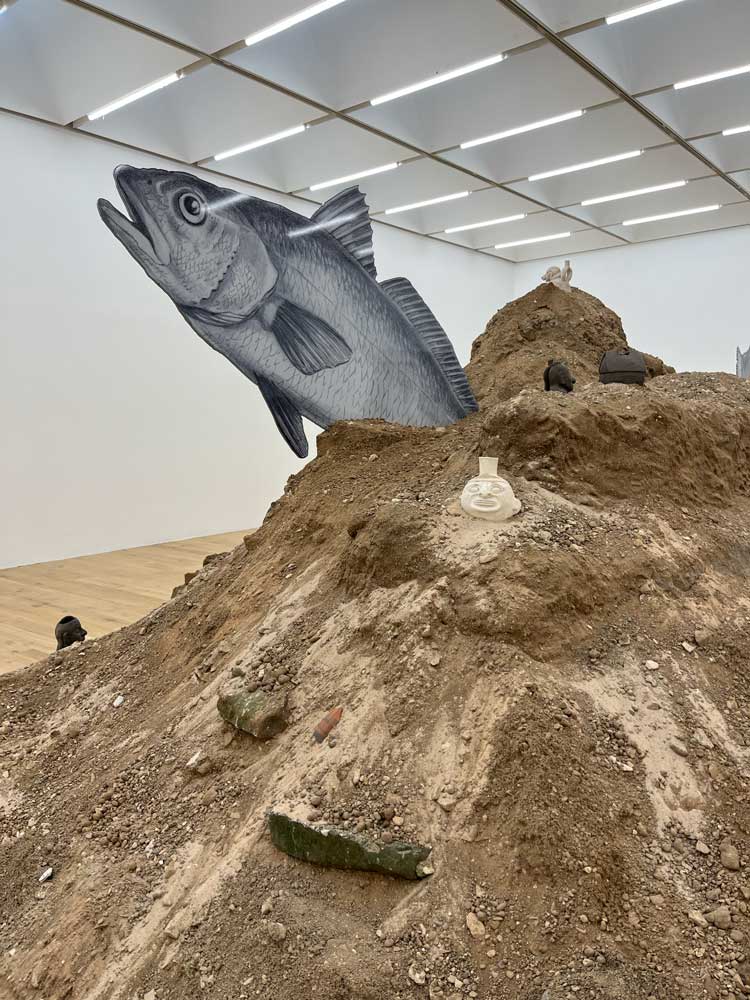
Claudia Martínez Garay, Wakchakuna / We Who Share Everything and Nothing, installation view, Nottingham Contemporary, 25 May – 8 September 2024. Photo: Veronica Simpson.
VS: I am sure the Scots will relate to that theme of resisting oppression, given the turbulent relationship they have had with the English.
CMG: I’ve heard only a little bit about that. The people in Dundee are all so friendly, and very warm. I am really glad I got a chance to come here and experience a little bit. And I’m pretty sure some people from Peru must have come and fallen in love with Scotland. We have a soft drink in Arequipa called Scottish cola. And I sometimes show this bottle in my work. It’s a cola that a lot of people whose families come from the mountain parts really appreciate. There is also an English Cola, but people here have never heard of it.
VS: I can see why that interests you – the iconic objects that translate or transfer between cultures. But some cultural themes are much harder to translate or convey, such as the ancient Andean cosmology you are representing in your textiles, your Pachas, of undivided unity in time and space.
CMG: That’s such a difficult aspect to grasp. That’s why I decided to make a series, and it’s ongoing. I’d love to end up with 100 Pachas. So far, I have made about 14 or 15. Each of them is a number, and each of them I see from the point of view of wanting to explain how life was on Earth, for example to someone who was not from here. This notion of undivided time and space is very non-western.
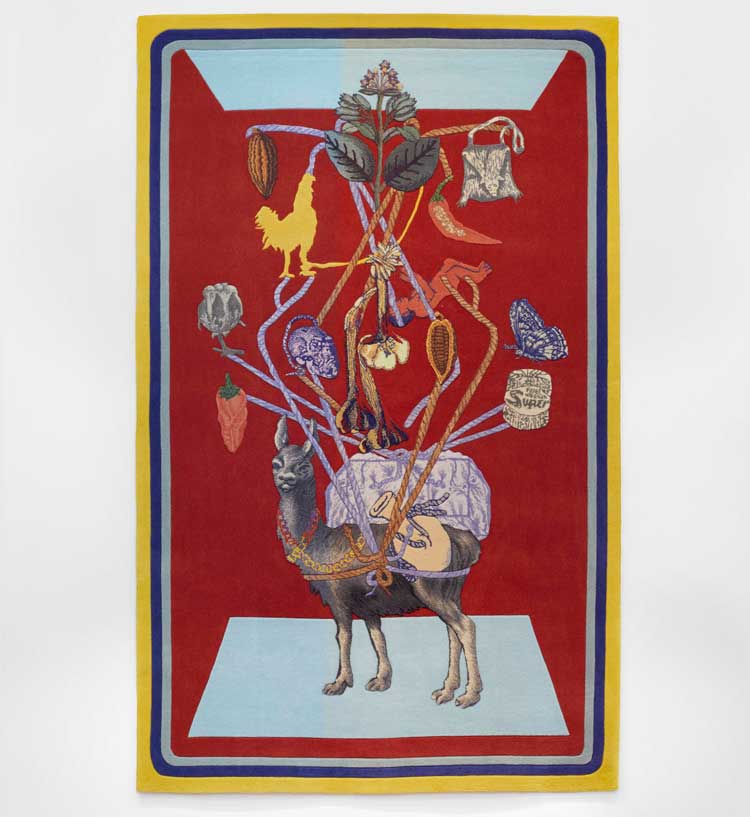
Claudia Martínez Garay, Chunka Tawayuq Pacha, 2022.
VS: What’s going on, for example, in this one: Chunka Tawayuq Pacha, with the llama and the ropes?
CMG: I was thinking about this as a structure, inspired by the Corta Montes [an Andean harvest ritual with a tree as its focal point, which is decorated with multiple objects and danced around; each member of the community has to strike it with a few blows using a small axe until one of them cuts it down]. The tree has very banal, non-important things put on it, useful things. Because it has all these decorations, people want to cut it to grab the stuff, but also if you strike the final blow, you have to put it up next year. There’s a bit of negotiating going on. I’d always wanted to make a work based on that image, that use, that feeling. In the work, I put this kind of rhizome structure, a collage of things like those on the back of a llama. For me, it’s like the sensation of the heavy burden on the back of an animal. But it’s the weight of things you don’t want to leave behind. In the upper part, there’s an illustration of a cinchona tree, the bark of which was exported to Europe to extract quinine to cure malaria. It’s a very special plant from South America. The middle part has a Cantua flower [Cantua buxifolia], which is Peru’s national flower. But many of the symbols that are meant to be indigenous are now sometimes seen as bad by people on the far right. If it’s about brown proudness or being happy coming from certain ethnic groups, it’s not so well regarded. On the left of the work, there’s a skull, a trophy head with a cranial trepanation, representing early surgery that was practised by some cultures, especially along the southern coast of Peru. There is also an object representing a very recent advertisement for toilet paper called Super. It was very important to realise how people would cherish this so much after Covid. This (artwork) was made during Covid. I put those chains on the neck of the llama. But I realised afterwards it reminded me of how Mexicans wear their bullet belts (bandoliers).
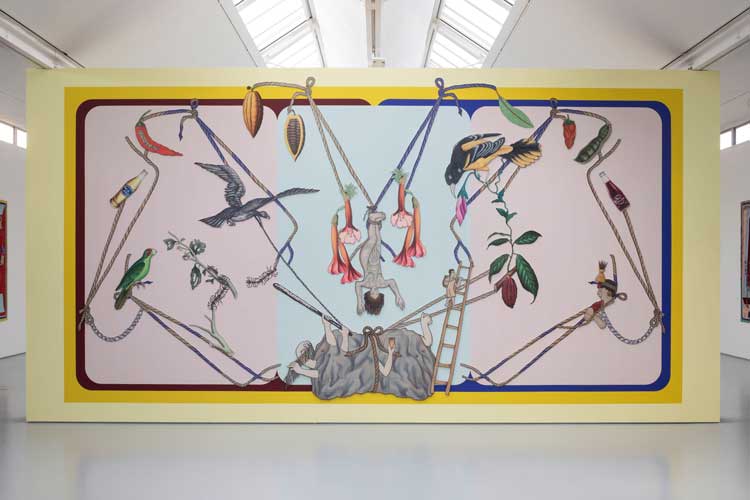
Claudia Martínez Garay: Every seed is awakened, installation view, Dundee Contemporary Arts. 24 August – 17 November 2024. Photo: Ruth Clark.
Elements from this work also appear in the new mural I’m making in Dundee: it has ropes, a big stone, it’s kind of a structure. I have been researching the chronicles of Waman Poma (Felipe Guaman Poma de Ayala, c1535-1616, a Quechua nobleman noted for his illustrated chronicles). He was writing about all the savage practices within the empire, the brutality within the culture but also the Spanish attitude towards the Indios. I saw this image of the woman who has been hung upside down: she is being punished because she’s been unfaithful. With this image, I have all this tension, but I want to show things that could still be precious beautiful things that are in nature, that you want to uplift or show their values.
In the lower part of the image, again you see this rock. It has hands, one is holding a bat, there’s a hand with a drink and a stone. All those things have the potential to do harm, that’s how I see it. And there are little ants as well, making their way but they are unable to connect. The mix of the things that you’re seeing here make some kind of sensation or atmosphere. Maybe at first glance it’s pretty, or maybe uncomfortable. I put a title to this one, from one of my favourite books by John Berger: Hold Everything Dear. He’s telling stories about the places he visited, and they are usually sad or about war or about different situations, where there is a lot of despair in general. Most of the time, I feel the beauty and despair in his writings. Hold Everything Dear is about the feeling that I don’t want to forget what I’m reading. I don’t want to forget the things that are so hard that haunt you for the rest of your life. But that doesn’t change the good things. And it’s important not to let go of those things. But we also need to see the things we don’t want to see.
• Claudia Martínez Garay: Wakchakuna/We Who Share Everything and Nothing is at Nottingham Contemporary until 8 September 2024..
• Claudia Martínez Garay: Every Seed is Awakened is at Dundee Contemporary Arts until 17 November 2024..